This is the third of a four-part series by CMRT’s David Tuck, discussing the history of the Castlemaine-Maryborough railway line. Part 2 described the context for railway expansion in Victoria; Part 3 looks at our specific line.
Having built superbly engineered lines to the goldfields in the 1850s, Victorian Railways decided in the following decade to use less steel on the tracks in order to save money. Expense could also be saved by pushing grades to the limit to minimise the number of cuttings and viaducts needed. That limit is a grade of roughly 1 in 50 or 2%, which is pretty gentle.
Here’s what a grade of 2% looks like:

It’s not hard to understand why cyclists love riding rail trails!
Work on our line began in September 1872, when Railways Minister Duncan Gillies ceremonially turned the first sod, just south of the railway bridge over Barker Street in Castlemaine. Councils and individuals had been lobbying for this line for at least a decade. Our line could well have been routed via Maldon rather than Newstead, with vigorous campaigning from both sides. Presumably the more direct highway route that we use today was rejected due to the lay of the land. The chosen route follows the Campbell’s Creek valley to Guildford, and then the Loddon valley to Newstead.
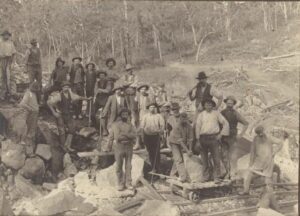
A few days before our line opened, a journalist for the Kyneton Guardian contrasted its workmanship with the Main (Melbourne- Echuca) Line. He was not impressed: some grades were twice as steep as any found on the Echuca line; moreover, he noticed that the ballast on our new line was thin and narrow, with gravel rather than road metal being used in places.
How long will passengers be content to creep along such lines as the Maryborough one at the rate of 12 or 15 miles an hour, when they can be whisked from Castlemaine to Melbourne at from 25 to 30 miles per hour?
The construction of the line took almost 2 years to complete. It was built in two sections by different contractors: Castlemaine to Newstead, and Newstead to Maryborough, with each section costing about £50,000 – a total of £100,000 – or roughly $15 million in today’s money. Construction costs were widely reported to be £5280 per mile, which multiplied by the 34 miles equals £180,000 – a lot more than the £100,000 contractor fees. Converted to modern currency equivalence, this gives us about $26 million. Maybe this figure includes stations, land acquisitions and who knows whatever else, but regardless, it still sounds like a bargain.
At first, briefly, our line looked like a branch line from Castlemaine, terminating at Maryborough, but as we can see from the 1930 map, it was to be part of a network going through to Hamilton, and also much later, north into the Mallee.
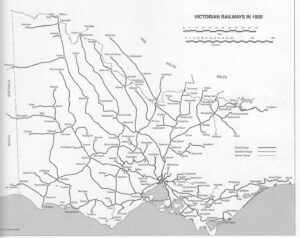
The first Maryborough railway station
Significant though it was, the actual opening of the railway at Maryborough on 7 July 1874 proved to be something of an anticlimax: no crowds of on-lookers, no speeches, no celebrations of any kind. It was winter, and the unfinished station stood in a sea of mud.
On this same day, the eleven-mile line from Ballarat to Creswick was also opened, again without fanfare. Construction of that line reached Maryborough early the following year. It too was a light line, much to the chagrin of the engineers.
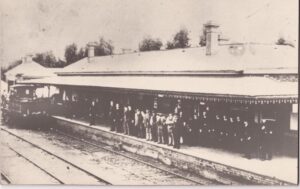
There were initially five stations between Castlemaine and Maryborough: Guildford, Newstead, Joyce’s Creek, Moolort and Carisbrook; most were not completed until soon after the opening of the track. Maryborough, Newstead and Carisbrook stations were provided with grander architecture. Campbell’s Creek opened in 1888, Strangways in 1893; Yapeen district was judged worthy of only Rail Motor Stopping Place status, and Strangways was demoted to that status in 1955.
The elegant and grandly-dimensioned station building that Maryborough boasts was not built until 1891, replacing a far more modest structure. Speculation that clerical error had created a building in Maryborough that was actually intended for somewhere else is wrong. The station was built at the tail end of a boom decade in Victoria when railways were king, and Maryborough was a central hub in that network; the Maryborough Railway Station was meant to reflect that status. It cost £22,000 to build, which translates to around $3.25 million today. The original station building had cost only £4,000.
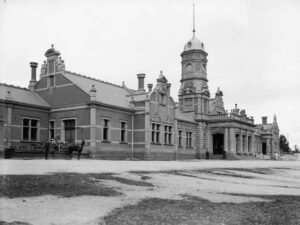
Mark Twain stopped at Maryborough Station on his way from Bendigo to Ballarat via Castlemaine in 1895 and, marvelling at the extravagance of the building, famously described Maryborough as “a railway station with a town attached”. He was not a happy traveller, however!

“They spend tons of money to house you palatially while you wait fifteen minutes for a train, then degrade you to six hours’ convict-transportation to get the foolish outlay back. What a rational man really needs is discomfort while he’s waiting, then his journey on a nice train would be a grateful change…. Look at the rolling stock! That’s where they save the money. Why, that train from Maryborough will consist of eighteen freight-cars and two passenger-kennels; cheap, poor, shabby, slovenly; no drinking water, no sanitary arrangements, every imaginable inconvenience; and slow? – oh, the gait of cold molasses; no airbrake, no springs, and they’ll jolt your head off every time they start or stop.”
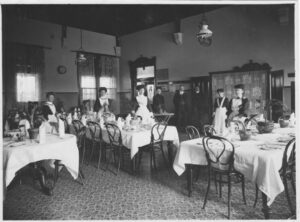
Curiously, Twain did not mention the sumptuous dining room!
